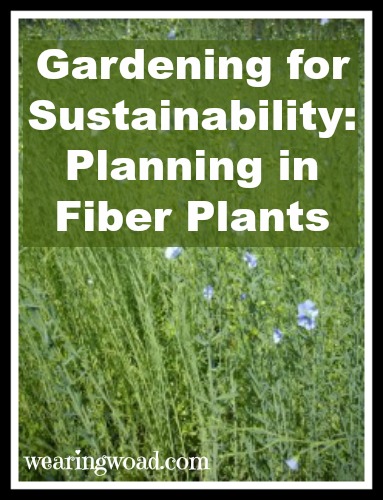Sustainable dyes for sustainable fashion is only one side of the gardening coin. Growing and producing your own sustainable fibers to pair with your epic homegrown natural dyes is the other. Nothing will have a smaller ecological footprint than the fiber and dye grown within a few yards of your back door, and processed by you. No commercially produced garment will ever match your home grown and fashioned garb for last, or the sense of accomplishment you will have from wearing your own creations.
If you would like an overview of specific fiber plants that can be grown in North America, you can check out this article on growing your own plant fibers.
Garden Evaluation:
The first question should be, how much space do you want to dedicate to your fiber plants? Fiber plant space is space that will be unavailable for food, or dye plant growing for that season. 
Linen is the fiber plant I have the most experience with, so that is what I will use that for an in-depth look at what growing fiber plants requires.
For Linen:
Flax plants can handle cold nights, and the unpredictable temperatures in the mountains. Flax, whether for linen or not, needs at least a two and a half month growing season from planting to the date of harvest. Harvesting happens just as the flax plants start to dry and before the seeds are brown (seeds will ripen after harvest).
Flax for linen should be planted close together, to prevent branching and encourage fine stems. The finer the stems, the finer the resulting linen is supposed to be.
While linen is easy to grow, the hard part is the weeding. Flax should be weeded at least once, and preferably twice, before it reaches six inches in height. After flax is six inches tall, it becomes too brittle and will snap if stepped on. Before six inches it is flexible enough to recover if stepped on during weeding.
If you have a lot of time for weeding, a twenty by twenty patch could give enough linen to keep you busy for the winter (about enough for six tea towels after all processing and spinning I believe). If you are just starting with linen flax, a two by two bed should give enough linen for a few small items and some easy experimenting. Not to mention a lot easier weeding.
Due to the fact that Flax for linen needs a fairly large garden area, it may be easier in warmer areas to grow another fiber crop (like colored cotton).
Flax likes well-drained soil, with a moderate helping of compost and such. when I first began growing flax, the soil was quite poor, but the plants still grew well and the fiber was still of good quality. In regards to growing flax for linen, it is really the space needed to grow enough plants to make the processing worthwhile that is the challenge.
Nettle:
Most people do not plan nettle into their gardens. However, I recently read a very interesting use for nettle plants. In this article, it suggests that nettles could be grown as a perimeter “fence” in certain emergency situations both for food, and to protect more valuable food crops from being noticed.
As a fiber artist, I immediately thought that the fencing idea is a very good one, particularly if you know how to process nettle into fiber. Then you not only have a nice perimeter fence and a bit of a food supply, but you also have fiber just waiting to be processed!
My first experiment with nettle was actually harvested from the neighbor’s horse pasture, because the horses were staying far away from the nettles. So, even if you don’t have a nettle patch on your property, a neighbor may have one that they’d be very happy to be rid of. Just remember if you want to raid the neighbor’s nettle patch, ask first!
Cotton:
If you are in an area that can grow cotton. Good for you! I want to try it in a container sometime, as I’m fairly certain that cotton would not get along with summer frost J
You can find out a bit more about growing cotton here.
The Value of Growing and Processing Your Own Plant Fibers:
One very important part in growing and processing your own plant fibers is keeping these ancient skills alive. The ability and knowledge behind creating your own fiber and clothing from linen, nettle, and other home-produced fibers is no longer common knowledge.
Knowledge is something that, if it is not practiced, it will be lost. This is particularly relevant in relationship to plant fibers, creating your own natural dyes, and generally being able to create your own essential clothing. The ability to dye with woad was nearly lost after the introduction of Indian indigo, and even the ability to home process linen was nearly obsolete before someone recognized its value and recorded it.
If you are interested in the prepping side of things, just think for a moment what would happen in an “end of the world as we know it” situation and all the conventional clothing begins to wear out. If you don’t know how to make your own cloths from wool, leather, or your own plant fibers, what would happen?
Back To You:
What fibers might you consider adding to your garden, or your skill knowledge repertoire?
Leave a comment, I enjoy hearing from you!